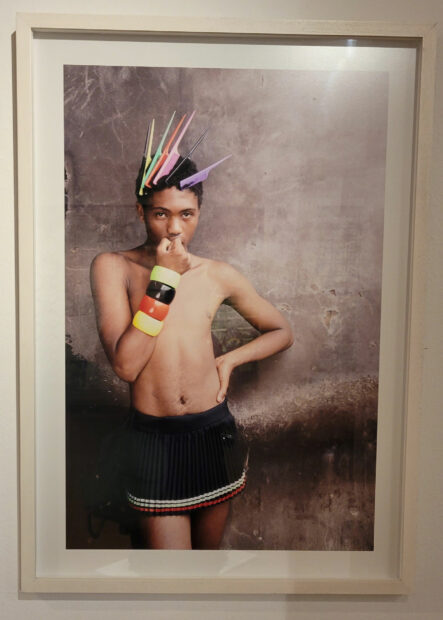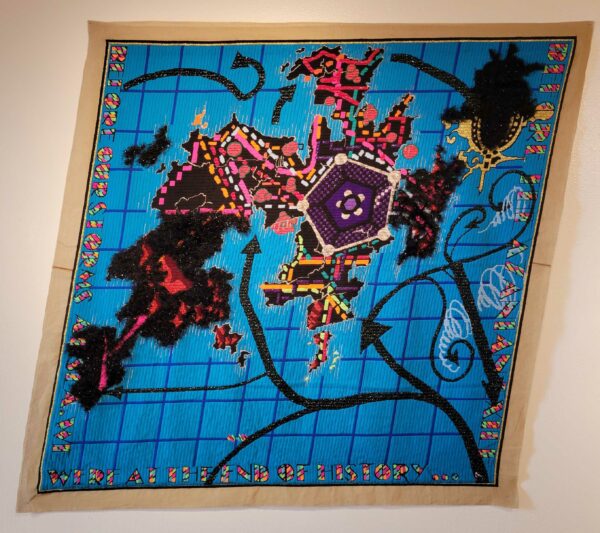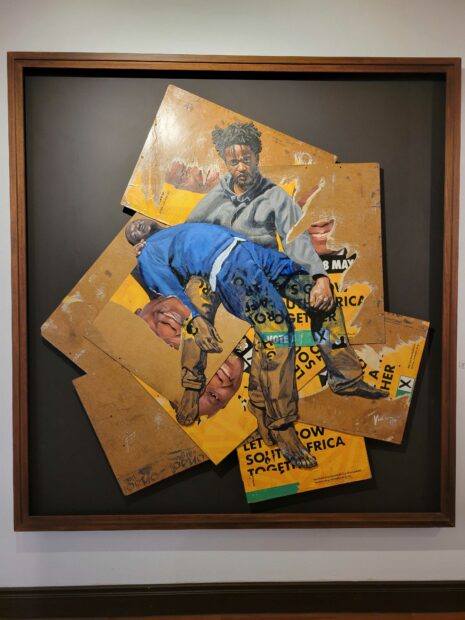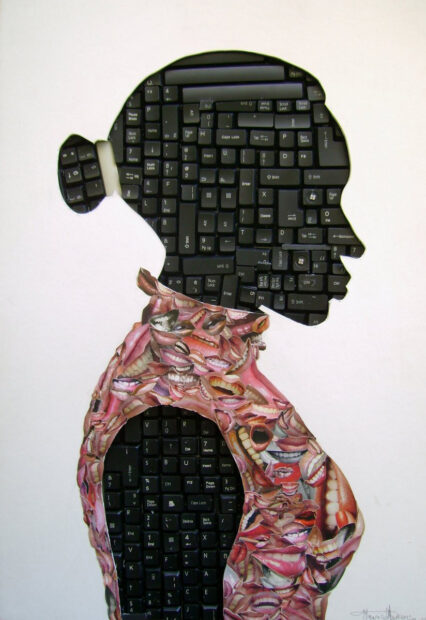The world debut of the Nando’s Art Collection, a collection of contemporary Southern African art held by the popular South African restaurant group, is quite the accomplishment for the African American Museum of Dallas. With 62 works by some of the most prominent artists working in South Africa over the past 70 years, If You Look Hard Enough, You Can See Our Future provides a wide-ranging glimpse into the creative strategies these artists use to document the turbulent history of their nation and fashion a new vision for the future. The beauty of the works alone makes a visit worth-while, but I truly believe the selection of Dallas as the debut location offers a far more exciting invitation.

Stephen Hobbs, “If You Look Hard Enough,” 2015, etching with aquatint and drypoint on Hahnemühle paper
The title of the exhibition is drawn from Stephen Hobbs’ 2015 etching If You Look Hard Enough and seeks to convey the universality of the issues addressed by the artists on view. I prefer to narrow the lens a bit. While these themes are universal, I think it is also impactful to consider how they manifest in particular ways in particular communities. The selection of the African American Museum of Dallas should not be glossed over with a quick stroke. Rather, it is worth taking time to see the parallels between the histories captured in this exhibition and the history of Black communities in Dallas.
Vivien Kohler’s 2019 Pieta confronts viewers in the portraiture gallery of the exhibition. Several boards arranged in a dynamic, swirl-like composition are covered with torn campaign posters featuring African National Congress President Cyril Ramaphosa from the 2019 parliamentary elections. Painted over the top, and conjuring the classical image of a pieta, a slain Black man lays limp in the arms of another Black man who stares out at us with an expression that is hard to fully describe and decipher. Is it pain, anger, or some combination? Large in scale, it is hard not to feel a part of this scene, this moment. The stance of the man is so strong and alert that it maintains an air of action that heightens the sense that this death has just occurred. I felt shame at my own inaction as this man’s gaze pierced through me out of the highly-charged scene.
The attention of the world was on South Africa in the late 1980s and early 1990s as movements to end apartheid reached a fever pitch. So much excitement was generated about a more equitable future for South Africa when apartheid finally ended. However, where has that attention and care for the people of South Africa gone in the subsequent years? Economic inequality remains high, disproportionately impacting Black South Africans. While the campaign posters draw our attention to the corruption that has plagued the South African government in the years leading up to the 2019 election, they also bring to mind the institutional violence South Africans still endure; police violence is high. The eyes of the world turned to Minneapolis in 2020 with the murder of George Floyd, but Kohler’s works remind us that the loss of young Black men at the prime of life is a rampant problem beyond the United States. The pieta has a long tradition in the Western art historical canon and immediately conjures compassion and empathy. The challenge here is how long empathy lasts. Does it fade with the news cycle, or remain sustained so long as the problem persists?
For Dallas-area viewers, this work likely hits close to home. In the past few years, we have seen the murders of Botham Jean and Jordan Edwards get high levels of media attention. However, we recognize that attention alone does not effect change. We must continually shine a spotlight on cases of excessive force and institutional failures to protect communities.

Zanele Muholi, “Mini Mbatha Durban, Glebelands, Jan. 2010” (from the “Beulahs” series), 2010, C-type
As legislative attacks against LGBTQ+ communities steadily increase, Zanele Muholi’s Mini Mbatha Durban, Glebelands refocuses our gaze on this marginalized community in South Africa. Muholi has received much critical acclaim for their Faces and Phases, a series of portrait photographs in which Black lesbian and transgender individuals reclaim their agency in South African visual history. The photograph on view in this exhibition is from Muholi’s Beulahs series and is provocatively conversing with colonial portraits. In this photograph, a young man poses in front of a dingy, concrete wall. He stands shirtless, wearing a mini, pleated tennis skirt, with bright wide bangles and rat tail hair combs in varying colors fanning out across his hair. His coy expression is intentionally performative, referencing colonial efforts to sexualize women of color.
As a viewer, I am reminded of the current legislative battles here in Texas regarding LGBTQ+ issues. Largely at question, whether discussing drag performances or books in school libraries, is if that content is inherently sexual. Muholi forces us to reconsider how we project sexuality onto the bodies of members of LGBTQ+ communities. This photograph is highly provocative; however, it is mirroring how we sexualize all content associated with these communities to permit easy classification and legibility. In our current discourse, there is a flattening and reduction of LGBTQ+ peoples to their sexual orientation rather than an acknowledgement of their full expression as individuals. Muholi’s portrait is a confrontation to viewers, reminding us of these communities and challenging us to examine how we read this picture. Do we assume the image documents the reality of this young man? Or do we recognize the powerful forces that are attempting to shape the narrative around him?
In this exhibition, portraits are parsed out into a separate gallery from landscapes and abstract works. However, there is some beautiful overlap that is not fully cultivated by this arrangement. Although a portrait, Maurice Mbikayi’s Untitled is ultimately a commentary on land and its use. In this work, we see the silhouette of a woman wearing a patterned, pink shirt. Her skin and hair are fashioned from computer keys. Instantly my mind went to Hidden Figures and the roles Black women play in science and technology, often without full recognition of their contributions. However, this reflects my United States-centered worldview. What had escaped my understanding was the importance of African gold, cobalt, and coltan mines in the manufacturing of computer components. While the mining industry does provide jobs, the financial benefits of the tech industry are certainly not widely felt by the workers enduring harsh conditions to source its foundational components. Further, we must consider whether safety and health risks are properly balanced with the financial benefit.
Additionally, Mbikayi wishes to draw attention to the exporting of e-waste to the African continent, transporting toxic materials to pollute the lands and, as a result, the bodies of Africans. This immediately conjures memories of shingle mountain in Dallas, a 60-foot pile of discarded roof shingles illegally dumped in a predominantly Black and Latino residential neighborhood, which resulted in toxic particulates accumulating in the surrounding air. There is also the asphalt plant in the Joppa neighborhood, harming air quality in a predominantly Black area for years despite community complaints. The willingness for cities and nations to prioritize industries and economic gains over the environmental and physical health and wellbeing of communities of color is an ongoing struggle in the United States and the Democratic Republic of Congo, Mbikayi’s country of origin.

Athi-Patra Ruga, “Escape to the End of History (from the Future White Women of Azania Saga Series),” 2015, thread, wool on needlepoint canvas.
In the landscape and abstract gallery, visitors will find Athi-Patra Ruga’s tapestry Escape to the End of History. Reminiscent of a map, a rich blue fills the background and black landforms with bright embellishments suggest distinctive territories. Arrows swirl around the landforms, alluding to movement and migration. At the center of the work is a pentagon with a thick outline, suggesting containment. This is Azania, a mythical land intended to be a Black utopia free from outside rule, championed at the 1965 Pan Africanist Congress. Azania has historical roots, dating back to the Roman Era, as a revered territory in Eastern Africa. In the 20th century, the term was appropriated to refer to a decolonized South Africa. In many ways, Azania parallels the artist’s home, the Republic of Transkei, a semi-autonomous Black homeland during the late years of apartheid. Unfortunately, the dream of this Black homeland was not fully realized and it was ultimately reincorporated fully into South Africa. Ruga’s fictive Azania is no utopia. It is ripe with vice, decadence, competition, and striving.
In this particular work, the Azanians have been exiled and are at the “end of history.” This is an intriguing concept — there is plenty of scholarly debate about what the end of history is and if/when it may occur. To be clear, the end of history is not that moments of importance cease, but that our creation of historical narratives in the modern tradition ceases. The modern tradition referrs to historical narratives that privilege linear, inevitable consequences and prioritize the perspectives of victors. The end of history is intimately intertwined with postmodernism where attachments to universality are displaced by diversity.
I am fascinated by the idea of maps. They are remarkably powerful images; they can assert claims and power, and strike communities and culture from future memory. We often take them as fact, yet they shift and are often not reflective of the lived experiences of the people inhabiting their lands. Even in Dallas, it is interesting to reflect on how communities have shifted over time. Regardless of one’s stance on gentrification, it does affect our understanding of neighborhoods and will likely have long-term impacts on maps, particularly school boundaries and political districts. The conversations about how best to preserve historically Black neighborhoods in Dallas already reflect concerns about new residents claiming prime properties, asserting power, displacing existing residents (primarily due to higher property taxes and rents), and removing cultural memory from communities.
Art for Art’s Sake
It is too easy for an exhibition to become another beautiful display of art. That would be a shame in this case as the work is particularly impactful. However, the impact comes when it lands with the right audience. To be fully transparent: museums generally have an outreach problem. That is not to say that museums do not want to reach out to the many diverse communities they serve, but instead, they are not yet successfully reaching out to these communities and fully bringing them into the fold of their primary audience. I personally think it is a communication problem. There is still a long legacy of wanting to celebrate art for art’s sake. To be fair, it is important to celebrate creativity and craftsmanship. However, I think many of our communities of color are looking for more. Museums are not consistently making the case of how art is relevant and resonant to our daily lives. To that end, I suggest we discuss art in this way:
Art for the sake of recognition.
Art for the sake of cultural preservation.
Art for the sake of justice.
Art for the sake of change.
And it cannot just stop with art. Art should serve as an inspiration and catalyst to take action and create a better story and a better history for future generations. I think the title of this exhibition may be right: If We Look Hard Enough, We Can See Our Future. Yet, we must move beyond looking. We need to connect and start acting out the future we want to see.
If You Look Hard Enough, You Can See Our Future is on view at the African American Museum of Dallas through October 21, 2023.
Correction August 3, 2023: This piece has been updated to reflect the number of works on view in the exhibition, and the show’s extended closing date. There are 62 pieces in the show, and the exhibition is now on view through October 21.




